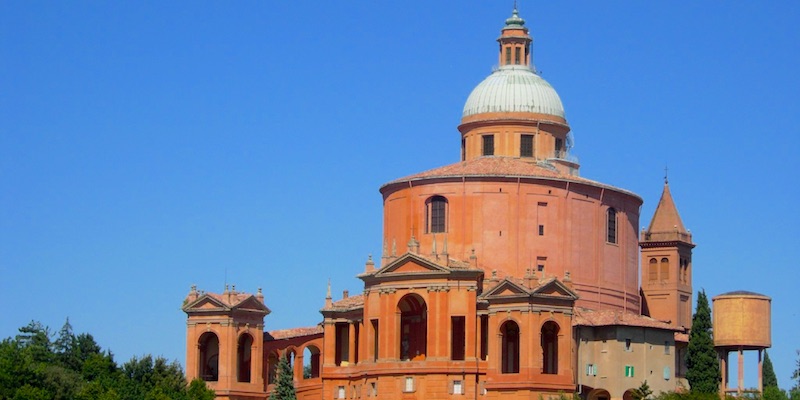Traditional place of worship for the presence of an image the Virgin of St. Luca as well as reassuring visual landmark for Bolognese approaching town, the shrine located on top of Guardia hill is one of Bologna's symbol. An arcade with more than 600 vaults - unique for its length covering almost four kilometres (3,796 m) - connects the shrine with the town and provide a shelter for the procession which every year since 1433 has brought the Byzantine Madonna with Child to the cathedral downtown during the Ascension week. Construction started in 1674 with the building of the Bonaccorsi archway by G. G. Monti over Saragozza Gateway. The same architect was also assigned the designing of the final project for the layout of the arcade at the foot of the hill, with extremely sober and simple style, later followed by his successor C. F. Dotti, starting from the second decade of the 18th century. The end part of the arcade on top of the hill, designed by the latter, is instead characterised by a dynamic variation of perspectives and vanishing points up to the final view of the shrine. The start of the climb is marked by the Meloncello Archway along via Saragozza, designed by Dotti with the likely contribution of the stage designer Francesco Bibiena. The aedicule with its curved plan and the recourse to the free column represents, together with the open area outside the basilica, the only outdoor example of Baroque in town. Today's church was built by Dotti between 1723 and 1757 in place of an earlier 15th-century church, while the two outside tribunes were brought to completion by his son Giovanni Giacomo in 1774. The outside structure fully in tune with the Bolognese tradition, is devoid of emphatic and solemn decorations, displaying the characteristically simple curve profile supporting the dome. The indoor structure with an elliptic plan opens up in a Greek cross ending with the main altar standing before the chapel of the Virgin. Decorations are made by V. Bigari for frescoes, A. Borelli and G. Calegari for stuccoes and A. Piò for the statues. Of the artists decorating the church the most important are G. Reni (third altar on the right), D. Creti (second chapel on the right), G. Mazza (chapel of S. Antonio da Padova), Guercino (high sacristy).
In 1930 Ferruccio Gasparri made a cable-way which, with a single pylon, by-passed a slope of 220 metres between via Saragozza and the shrine. The controversy around the cancellation of the devotional course terminated with the final closure of the cable-way.
Are you a local? What do you think about Saint Luke's Sanctuary?
Login to suggest it!


